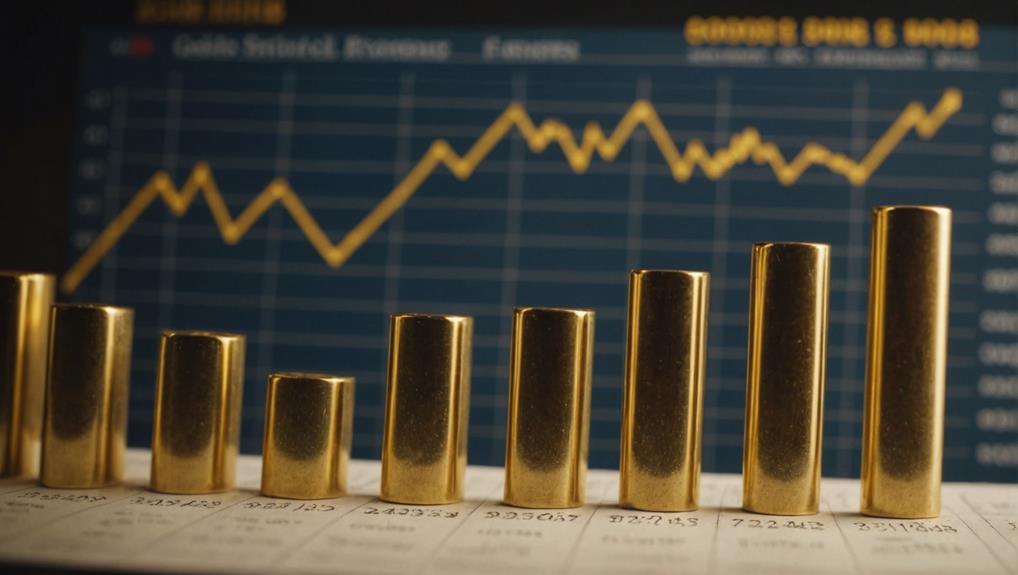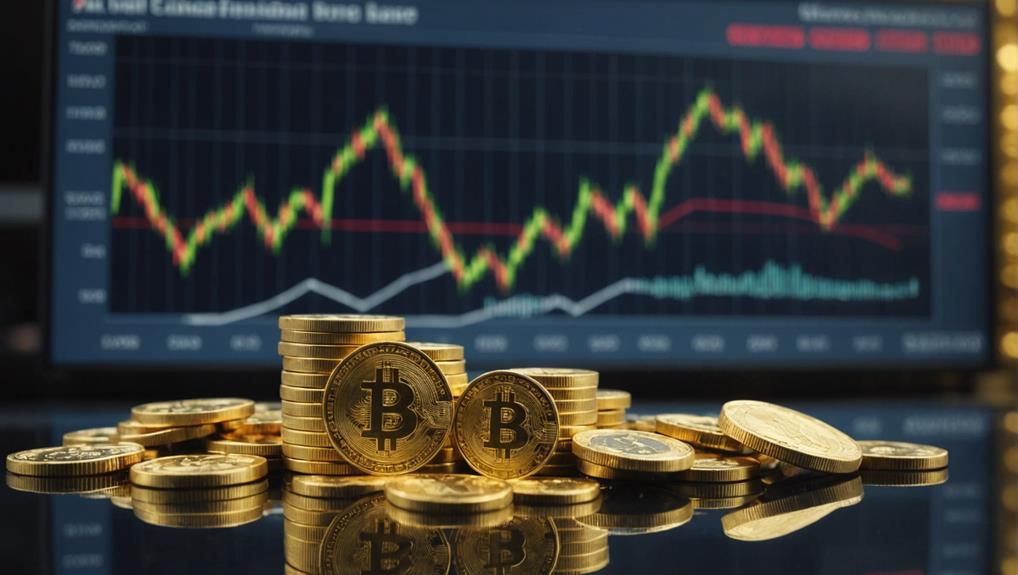Investing in gold during times of inflation provides a reliable means to safeguard wealth as fiat currency depreciates. Its historical resilience and limited supply make it an attractive choice for hedging against economic instability.
By incorporating gold into a diversified portfolio, investors can mitigate risks associated with market volatility and maintain their purchasing power.
Understanding the diverse benefits of gold investments in inflationary periods necessitates a deeper analysis of its role in long-term financial strategies.
Key Insights
- Gold preserves value during economic uncertainty, acting as a reliable hedge against inflation.
- Gold's low correlation with traditional assets enhances portfolio diversification and stability.
- Historically, gold prices have increased during inflationary periods, averaging 14.9% from 1974 to 2008.
- Limited supply and intrinsic value make gold a stable asset for wealth preservation.
- Gold investments provide a safeguard against the erosion of purchasing power in inflationary times.
Historical Performance of Gold

Gold's historical performance as an inflation hedge has been characterized by significant variability. In the 1970s, gold bullion, coins, and bars delivered impressive annual returns of 35%, solidifying gold's reputation as a premier hedge against inflation.
However, in the early 1980s, despite persistent inflation, gold prices experienced a decline of 10% annually from 1980 to 1984. This demonstrates the unpredictable nature of gold as an inflation hedge.
Over different time frames, gold has shown mixed results compared to real estate, commodities, and the S&P 500, sometimes underperforming.
Even in recent extreme inflationary periods in the U.S., gold investments have yielded negative returns, indicating the challenges of relying solely on gold as a consistent hedge against inflation.
This historical inconsistency underscores the complex and multifaceted factors that influence gold's performance as an inflation hedge over time.
Gold as an Inflation Hedge
Gold is widely recognized as a reliable hedge against inflation, as it has a proven track record of preserving value during times of economic uncertainty. When inflation rates spike, the price of gold typically rises in response to the increased cost of goods and services.
Historical data from 1974 to 2008 shows that gold prices surged by an average of 14.9% during periods of inflation, highlighting its role as a safeguard against the erosion of purchasing power. With its limited supply and intrinsic value, gold remains a stable asset that investors turn to for wealth preservation in the face of rising prices.
Its reputation as a safe haven asset further solidifies its position as a go-to option during turbulent economic times, offering a reliable means of protecting wealth from the impacts of inflation.
Diversification Benefits

Gold's low correlation with traditional assets makes it a crucial component for achieving effective diversification in a portfolio, particularly during inflationary periods.
Low Correlation Assets
Gold's low correlation with traditional assets like stocks and bonds makes it a valuable tool for diversification in investment portfolios.
Incorporating gold ETFs and gold mining stocks can enhance portfolio diversification, offering a buffer against market downturns.
Gold's performance tends to differ from equities and fixed income securities, providing stability during economic fluctuations and potentially improving overall portfolio performance.
Portfolio Risk Reduction
Gold's inclusion in an investment portfolio plays a crucial role in reducing risks due to its low correlation with traditional assets. By diversifying the portfolio with gold, investors can benefit from its unique properties that help counteract market volatility and fluctuations in real interest rates.
Especially in times of economic uncertainty, gold serves as a stabilizing force, shielding against inflation and potential losses in other asset classes. This diversification not only enhances risk management but also ensures a more resilient investment mix.
Economic Resilience Boost
Integrating gold into an investment portfolio enhances economic resilience by providing diversification benefits that protect against inflation and market volatility. Gold holdings offer a stable asset that retains its value even in the face of inflationary pressures that diminish the purchasing power of other investments.
Including gold in a portfolio enables investors to achieve a more balanced and robust financial strategy, ultimately reducing overall risk.
- Low Correlation: Gold exhibits a low correlation with traditional assets such as stocks and bonds, serving as a buffer against losses during market downturns.
- Stability: Gold functions as a stabilizing factor, helping to mitigate the impact of economic upheavals.
- Tangible Asset: Gold represents a physical, tangible asset with enduring value, offering a safeguard against currency devaluation.
Therefore, investing in gold strategically bolsters economic resilience and fortifies financial portfolios against uncertainties.
Ways to Invest in Gold
Investors have various options to invest in gold, such as owning physical gold like coins, bars, or jewelry, which provides a tangible and secure asset.
Exchange-traded funds (ETFs) like SPDR Gold Trust (GLD) offer a convenient and liquid alternative to gold investment without the need for storage.
For diversified exposure to gold-related assets, including mining stocks and bullion, investors can consider gold mutual funds.
Those looking to speculate on future gold price movements can utilize gold futures, potentially leveraging their investment for higher returns.
Each method caters to different investment strategies and risk appetites, presenting unique advantages for investors to consider.
Risks and Considerations

Investing in gold during inflation entails considering various risks and factors that can significantly impact returns. The unpredictability of gold price trends is influenced by changes in interest rates and market sentiment. Additionally, market manipulation by large players can result in significant price volatility, introducing additional risks for investors.
Factors such as currency fluctuations, which can affect the value of gold investments, are particularly crucial during inflationary periods. Moreover, regulatory changes may impact gold trading and investment practices, potentially affecting returns.
It is important to note that a lack of market knowledge among inexperienced investors can lead to losses due to an inadequate understanding of the complex dynamics of the gold market. Therefore, careful consideration of these factors is essential for making informed investment decisions.
Comparing Gold to Other Hedges
Comparing gold to other hedges reveals distinct differences in their effectiveness and characteristics for inflation protection. Gold has demonstrated greater stability than Bitcoin, particularly evident over the last two years. Its longstanding presence in central bank reserves attests to its reliability amid evolving monetary policies and inflationary conditions.
While Bitcoin's finite supply is appealing, its performance as an inflation hedge has been more erratic. The contrasting behaviors of gold and Bitcoin in response to inflationary pressures indicate that gold remains a more dependable option.
Investors evaluating inflation protection strategies should carefully consider these factors, acknowledging the unique roles each asset fulfills in their investment portfolios.
Optimal Portfolio Allocation

To achieve optimal portfolio allocation during inflationary periods, it is important to consider how gold can improve diversification and mitigate risk.
Allocating 5-10% of a portfolio to gold leverages its low correlation with other assets, providing an effective hedge against inflation.
Diversification and Risk Mitigation
Diversifying an investment portfolio by allocating 5-10% to gold can significantly enhance risk mitigation strategies, especially during inflationary periods. Gold's unique position in commodity markets serves as a valuable hedge against economic uncertainty, helping to reduce overall portfolio volatility. Optimal portfolio allocation models consistently recommend including gold to improve risk-adjusted returns.
Gold offers stability in economic downturns.
It serves as a protective asset against inflation.
Including gold in a diversified portfolio can boost long-term performance.
Balancing Asset Correlations
In addition to bolstering risk management, maintaining a balanced mix of asset correlations within a portfolio can enhance its resilience in times of inflation.
Gold's minimal correlation with conventional assets such as stocks and bonds positions it as a valuable diversification tool. This distinctive quality plays a crucial role in reducing overall risk and volatility, especially in turbulent market conditions.
Research indicates that an optimal allocation of approximately 5-10% to gold can enhance risk-adjusted returns, serving as a stabilizing factor in a well-diversified investment portfolio.
By incorporating gold into their investment strategy, individuals can potentially improve long-term performance and navigate economic uncertainties more effectively, ensuring a more stable and robust investment approach.
Thus, carefully managing asset correlations is essential for achieving an optimal portfolio allocation during periods of inflation.
Long-term Wealth Preservation
Integrating gold into an investment portfolio can significantly enhance long-term wealth preservation, especially in times of inflation. Historically, allocating 5-10% of a portfolio to gold has proven to boost performance, especially during periods of high inflation. Gold acts as a reliable hedge against inflation due to its low correlation with other assets, making it a valuable component for optimizing portfolio allocation.
Incorporating gold in a diversified portfolio can:
- Reduce risks linked to economic uncertainty
- Offer stability and safeguard against currency devaluation
- Enhance overall portfolio performance during inflationary environments
Tax Implications
Understanding the tax implications of investing in gold is crucial for optimizing returns and minimizing tax liabilities, especially in times of inflation. Gold held in an Individual Retirement Account (IRA) provides the benefit of tax-deferred growth. Physical gold investments held for over a year are taxed as long-term capital gains, typically at a lower rate. In contrast, gold ETFs are considered collectibles and are subject to a 28% capital gains tax. When it comes to gold mining stocks, selling them within a year may result in them being taxed as ordinary income. To receive personalized tax guidance tailored to your specific situation, it is advisable to consult with a tax advisor.
| Investment Type | Tax Implication |
|---|---|
| Physical Gold ( >1 year) | Long-term capital gains |
| Gold ETFs | Collectibles, 28% capital gains tax |
| Gold Mining Stocks | Ordinary income ( <1 year) |
| Gold IRA | Tax-deferred growth |
| Tax Advisor | Personalized tax guidance |
Timing Gold Investments

Understanding the optimal timing for gold investments involves navigating market timing challenges, analyzing historical price trends, and adopting a long-term strategy.
Historical data indicates that gold prices often rise during inflationary periods, suggesting potential entry points for investors.
Market Timing Challenges
Navigating the complexities of market timing for gold investments amidst inflation can be challenging due to the unpredictable price movements. Unforeseen fluctuations often make it hard to predict the optimal times for buying or selling gold.
To address these challenges, investors should consider long-term investment strategies. Historical data suggests that while gold prices may fluctuate during periods of high inflation, taking a long-term view can help mitigate short-term volatility.
Key considerations include diversifying investments across various asset classes, exercising patience to allow investments to grow over time, and maintaining consistency by investing regularly regardless of market conditions.
Historical Price Trends
Analyzing historical price trends reveals the varying effectiveness of gold as a hedge against inflation over different time frames. From 1974 to 2008, gold prices surged by an average of 14.9% annually during high inflation years, demonstrating its potential as an effective inflation hedge.
However, between 1980 and 1984, gold prices experienced a 10% annual decline despite inflationary pressures, indicating the inconsistency in its historical performance.
Recent extreme inflationary periods in the U.S. have led to negative returns on gold investments, highlighting the evolving nature of its role as an inflation hedge. The value of gold relative to the Consumer Price Index (CPI) has shown significant fluctuations since 1972.
Understanding these historical trends is crucial in determining the optimal timing for gold investments.
Long-Term Strategy
Developing a long-term strategy for gold investments is essential for protecting against inflation and economic uncertainties. Gold's historical performance as an inflation hedge highlights its value over extended periods, offering stability and wealth preservation.
By analyzing past trends, investors can better understand how gold behaves in different economic cycles, informing their investment decisions. Diversification is key in balancing risk and enhancing portfolio resilience, making the integration of gold with other assets a strategic move.
Monitoring economic indicators, such as inflation rates and economic forecasts, provides valuable insights for timing gold investments effectively. Ultimately, patience and a strategic approach are crucial for capitalizing on gold's store of value characteristics and maximizing long-term returns.
Long-term Outlook for Gold Prices
The long-term outlook for gold prices remains promising due to its historical resilience and positive correlation with inflation. Gold has a proven track record of maintaining its value over time, particularly during periods of inflation.
With an average annual return of approximately 1.1% after adjusting for inflation in the past century, gold stands out as a reliable long-term investment option. Its consistent ability to act as a hedge against the eroding purchasing power of fiat currencies adds to its appeal.
The finite supply of gold and its intrinsic value further bolster its status as a safe haven for wealth preservation. Investors often turn to gold for stability and potential growth, making it a prudent choice amidst inflationary pressures.
Conclusion
Investing in gold during inflation provides significant advantages due to its historical performance as a reliable asset, effectiveness as a hedge against inflation, and its ability to diversify a portfolio.
There are various methods available to invest in gold, including physical gold, ETFs, and mining stocks, each catering to different investor preferences and goals.
While it is important to acknowledge the risks and considerations involved, a strategic allocation of gold can optimize portfolio performance.
Understanding the tax implications and carefully timing investments are essential steps to maximize the benefits of investing in gold.
Ultimately, gold stands out as a prudent choice for long-term wealth preservation in times of economic uncertainty.
The Gold Information Network
11900 Biscayne Blvd, Ste 127B, Miami, FL 33181
(305) 449-9094
https://goldinfo.net







